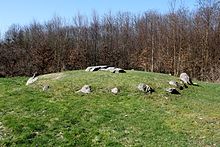Lykkesholm Castle
Lykkesholm Slot , now a hotel, has its roots in a medieval estate that belonged to Magelund Castle , west of Ørbæk on Funen in Denmark . This castle was moved to Lykkesholm on the banks of the Rosenåen- fed Mill Lake at the beginning of the 15th century . The place was completely surrounded by water by a ditch created in the north.
Lykkesholm
The oldest of today's buildings on Lykkesholm is the west wing with the protruding tower from the middle of the 17th century. Of the other buildings from this period, only the “Odense Gate” remains. There used to be two other gates, but the facility burned down in 1859.
Lykkesholm has had numerous owners throughout history. First the noble families Magelund, Rannow, Quitzow and Sehestedt and later bourgeois owners. In 1914 it was acquired by the Sehestedt Juul zu Ravnholt family and is still in their possession today.
The poet Hans Christian Andersen was inspired for several of his works on Lykkesholm, which he considered the most beautiful place on Funen:
- Just a minstrel
- The 12 months of the year
- The rosebud.
Magelund Castle
Only the impressive ramparts remain of Magelund, a mighty medieval defense structure. The castle was probably built at the end of the 13th century and was first mentioned in a document in 1329. The empire threatened to collapse at that time. A large part of the island of Funen was pledged to Count Holstein. It looks like Magelund was owned by the Holstein nobleman Gert Høcken for a while. In the course of the conflict, the castle came to the Danish noblewoman Peder Nielsen Brock.
When King Valdemar Atterdag (1340-1375) had defeated the Counts of Holstein, he turned against the Danish nobles. Many of the empire's castles were destroyed during these years. His daughter, Queen Margrethe I, followed in her father's footsteps. Castles that were not in the hands of the crown or subjects loyal to the king were razed. In 1391 the Queen bought Magelund and enfeoffed her loyal follower Henneke Olufsøn Bjørn with her. Magelund resembles the ramparts at Søbygård on Ærø , Ørkild in Svendborg and Hindsgavl near Middelfart .
The entire site is privately owned. The Magelund ramparts and their immediate vicinity are listed buildings, but are open to the public.
The prehistoric and historical monuments around Lykkesholm Manor are numerous.
- In the Hestehave Skov (forest) there are two long dolmen, a round dolmen and a chamber from the Neolithic Age (approx. 3500 BC).
- The Lindeskov Dolmen (Linden Forest) has the longest barn bed in Funen . It is 168 m long and 10 m wide. Most of the 126 curbs on the long bed, which was restored in the 1940s, are still original. In it, however, there is only a tiny ancient dolmen .
- The Ellested megalithic bed has five chambers and is one of the most famous multiple systems in the country.
- A castle was located in the Magelund ramparts in the 13th and 14th centuries. Your castle hill with a height of 15 m and a width of 70 m is very impressive.
- The Nymølle mill stood here until it was moved to an open-air museum north of Copenhagen .
- Gammelmølle is the oldest mill at Lykkesholm. However, today's buildings date from 1890.
In addition, the provisions of the Nature Conservation Act apply (see map). Bicycle route 51 Faaborg-Nyborg leads through the tunnel valley past Lykkesholm and the Magelund ramparts.
The dolmens
The prehistoric settlements of the Stone Age and Bronze Age were probably located on the lake, while the megalithic complexes are in and around the forest of Hestehave near Lindeskov. Most are elongated tombs with 1–3 chambers framed by curb stones. One of the dolmens was excavated in the previous century. In the chamber were a clay pot, two flint blades, and some amber beads . In the late Bronze Age (around 1100 BC) the hill was used for fire burials. The bones and ashes were collected in an urn or jar . The grave goods were determined by the sex of the dead: razors for men, needles for women.
See also
- Nordic megalithic architecture
- Great stone graves in Denmark
- List of castles, chateaus and fortresses in Denmark
Individual evidence
- ↑ (Danish Langdysse) is the common denomination in Denmark for dolmens that lie in a rectangular barn bed , in contrast to that, round dolmens are those dolmens that lie in a round hill
Coordinates: 55 ° 14 ′ 21.5 ″ N , 10 ° 37 ′ 6.3 ″ E


